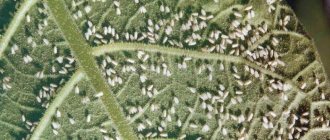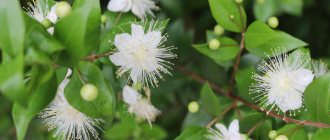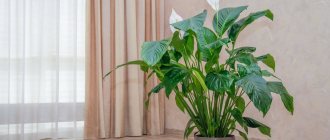When growing flowers in an apartment, you may find that they look ugly and have stopped growing. It is necessary to determine the cause and begin treatment appropriate to each specific case. A parasite such as aphids is often found on indoor plants. To successfully combat it, you need to know the available methods, and it is best to carry out preventive measures and create conditions that will prevent the appearance and reproduction of the pest.
What harm can aphids cause to indoor flowers?
Aphids on indoor plants are a common occurrence. The main danger of insect activity is the destruction of vegetation. Aphids pierce the skin of the leaves and suck out the juice. Colonies of parasites attack young and adult plants.
Single individuals lead to the drying out of several leaves of the flower; with timely help, the plant can be saved. A large accumulation of aphids on one indoor plant leads to its death.
Life cycle
Pests multiply at high speed. One female produces up to 100 larvae. The transformation into an adult lasts two weeks. In one year, from 14 to 20 generations change. Wingless insects are needed for reproduction; winged insects fly to new plants. Coexist with ants.
At the same time in the colony you can find:
- Larvae of 4 instars;
- Nymphs of 2 instars;
- Wingless and winged females.
In the fall, females lay eggs, from which massive colonies of larvae emerge in the spring. After molting and maturing, individuals enter the stage of asexual reproduction. The number of wingless females can reach hundreds of thousands. Natural enemies are ladybugs and hoverflies.
Winged females migrate to new flowers. Over the course of a year, dozens of generations of wingless and winged individuals are replaced. With the onset of autumn, fertilization by male winged individuals occurs.
Signs of pest damage
It is easy to see the presence of aphids on a plant - upon inspection, syrupy traces appearing from pest secretions and other symptoms are visible on the foliage.
Read more about why aphids appear on plants in the article here.
The first signs of aphid infestation:
- The shoots curl and wither. Young specimens of domestic flowers suffer.
- The presence of black marks on the leaves. Aphids spread sooty fungus, which appears as dark spots.
- Clusters of insects are noticeable on the underside of the leaves.
- Opened flower buds look ugly.
- Some flowers do not open.
There are several types of parasites. At the same time, the methods of combating it depend on the type of aphid. At the first signs of damage, it is necessary to immediately get rid of aphids. To do this, you need to choose the appropriate method and take preventive measures.
White
Dicotyledonous plants are most susceptible to attack by white aphids. Parasites are rare on domestic flowers. Aphids, covered with white pollen, penetrate the root system and suck out the juice. The plant dies.
Green
The parasite has a pale green color. Settles on bushes and trees. Dangerous for decorative Chinese roses, lemons, etc. Before winter, the female lays eggs near the buds. In the spring, the larvae hatch and parasitize the plant.
Black
Black aphids are dark in color and their body length reaches 5 mm. To pierce the foliage, a proboscis is located on the body of the parasite, with the help of which the insect drinks juice. Black aphids reproduce at a high rate because they do not need to mate. The larvae appear on young shoots of indoor plants and eventually move to adult specimens of vegetation.
Yellow
The yellow aphid has a corresponding color. Prefers to settle on coniferous vegetation near the buds. The primitive parasite does not spread to neighboring plants. One generation is hatched per year. Therefore, yellow aphids are few in number.
Effective methods of controlling aphids on coniferous trees
Bloody
The blood aphid is native to America. In its homeland, the insect parasitizes in the bark of elm trees. On the territory of Russia, the insect is found in gardens, rarely on domestic vegetation. The body of the parasite is covered with wool-like waxy threads.
Varieties found on flowers
Indoor aphids are polyphagous, attacking all plants except palm trees. The shape of the jelly-like body of insects can be oval, round, or elongated. Size – up to 3 millimeters. The head has eyes, antennae, and a proboscis. Three pairs of long legs allow the insects to walk and jump. Females come with wings and without wings. Males fly.
Aphids form colonies covering the lower parts of leaves, young shoots and flower stems. She prefers plant juices rich in carbohydrates and amino acids, which is typical for well-fertilized soil mixtures. The optimal condition for reproduction is moist and warm air.
The waste product of pests is a sweet sticky secretion. A fungal infection develops in these secretions. A weakened plant is affected by viruses and bacteria. Ants spread aphids due to their syrup.
Black aphid
Black aphid (indoor) affects all types of plantings. Body length – up to 1.5 millimeters. In a short period of time, the sprout withers, dries up and dies.
White aphid
Mealybug or hairy aphid. The oval light brown bristly body is covered with a white coating. House shoots affected by scale insects look as if they are covered with frost. The stems become bent, the foliage and buds fall off.
Beet aphid
An insect up to 3 millimeters long, green/brown/black with a waxy coating. Plants affected by beet aphids stop growing, curl, dry out, and may die.
How do aphids get into the house?
The most common type of aphid found on indoor plants is the aphid. Pests are located on the roots, leaves, stems and flowers of indoor plants.
Where and why do pests appear within the apartment:
- Purchase of an infected plant.
- Migration of parasites from the street on clothing or household items.
- Aphids enter from the street through open windows.
- Sticking of insects when airing flowers outdoors.
- The vital activity of ants, for which aphids are the main source of food.
Pests practically do not move around the plant. Aphids are found everywhere on domestic flowers, regardless of the part of the crop. First, young shoots are affected, then the parasite moves to denser and stronger areas. The leaves and stems turn yellow and curl into a tube. Aphids are visible to the naked eye.
A warm and dry climate promotes active reproduction of aphids. The infected flower must be quarantined so that other crops do not become targets of aphid attack.
General preventive measures
For house plants:
Weak flowers are most susceptible to attack by parasites.- It is necessary to promptly remove dry leaves and yellowed stems.
- New flowers must be quarantined.
- Do not overfeed the plants.
- Be sure to get rid of ants and choose planting sites with diffused light.
- Before planting in a new pot, the flower must be sterilized.
- Twice a week, inspect all plants in the house and regularly rinse them with running water.
For garden flowers:
- Systematically remove weeds.
- During the summer, destroy anthills. This must be done, since ants protect aphids in every possible way and even bring them into the garden themselves (read more about the symbiosis of these insects here).
- In the spring, carry out sanitary pruning of all plants.
- Before buds begin to bloom, spray fruit trees and flower stems with insect repellent.
- Do not overfeed plants with nitrogen.
- Wash plants with a hose.
Effective chemicals
Among the products that effectively fight parasites on indoor flowers, several chemical preparations can be noted - “Fitoverm”, “Aktellik”, “Iskra”, “Tanrek”, “Aktara”. The use of pesticides allows you to get rid of aphids on indoor plants in a short time. Treatment consists of spraying the crop. The main thing is to follow the dosage indicated in the instructions for use.
"Fitoverm"
The drug "Fitoverm" is of biological origin. Pests do not get used to the product. Therefore, treatment can be carried out until the insects are completely destroyed. It is recommended to take a week break between spraying. Dilution of the drug is carried out strictly according to the instructions.
"Aktellik"
The drug "Actellik" copes effectively with the task. The pesticide causes poisoning of parasites and their death. The toxic substance is dangerous for pets and children. Therefore, processing must be carried out outdoors.
When using the product indoors, the air temperature in the house should not exceed +15°C.
"Spark"
Several drugs are produced under the Iskra brand in different forms. To kill aphids, you can choose any type of product. The pesticide is considered moderately hazardous. Can be applied indoors and outdoors.
"Tanrek"
The insecticide is an effective product that is used to protect berries, fruits, vegetables and domestic crops. "Tanrek" is a domestic drug, available in bottles with different dosages (10, 50 and 100 ml). The main active ingredient is imidacloprid. It penetrates the structure of the plant, entering the parasite's body along with the juice. The death of aphids occurs within 24 hours.
"Aktara"
You can fight aphids on indoor plants at home using the drug "Aktara". The substance penetrates into the juice of flowers, causing poisoning of parasites. The action begins within a day. On larger plants, it takes longer to activate the product - up to two days. Aphids get used to the drug, so Aktar needs to be alternated with other pesticides.
Prevention
Preventive measures to help avoid infection:
- Newly acquired plants are placed separately from the collection for up to two weeks;
- Checking leaves and shoots for the presence of insects from early March to mid-autumn;
- Maintaining temperature conditions;
- Using sticky traps;
- Regular ventilation;
- Destruction of female aphids before they have time to lay eggs;
- Spraying with solutions of ash, herbs, mustard.
There are many different powerful remedies available to combat aphids. In the initial stages of infection, biological products, decoctions and infusions made from homemade ingredients have a good effect. In case of severe infestation, it is better to immediately resort to proven systemic insecticides.
Currently reading:
- Planting to decorate the site with three types of coniferous trees
- How to grow Chinese cabbage in open ground
- Effectively getting rid of whiteflies on plants
- Using hydrogel in open ground for plants
Share the news on social networks
About the author: Lyudmila Vasilievna Nosikova
Agronomist of the state agricultural enterprise "Garovskoe" of the Khabarovsk region of the Khabarovsk Territory.
Folk methods of struggle
It’s easy to quickly get rid of aphids with your own hands. This does not require the use of poisons that are dangerous to household members. There are many safe, effective folk methods. They can be used regardless of the reasons for the appearance of aphids. Among them there are infusions, decoctions and other effective remedies.
Ammonia
Ammonia is often used in pest control. Ammonia can also help control aphids on indoor plants. To prepare the working solution you need:
- Boil 500 ml of water.
- Add 1-2 tsp. grated laundry soap.
- Dissolve the grains.
- Cool the liquid.
- Pour in 2 tsp. ammonia.
- Mix.
The prepared solution must be sprayed onto the foliage from the top. Treat the bottom with a cotton swab dipped in liquid. After spraying, you need to wait 20–25 minutes and wash off the alcohol composition from the foliage with water. This will avoid the formation of a burn.
Red pepper
Aphids are afraid of some spices. You can effectively cope with parasites using red pepper. To prepare you need:
- Heat water – 200 ml.
- Add 25 g pepper (ground).
- Boil.
- Leave to infuse for 24 hours.
- Strain the solution.
- Add 1 tsp. soap
- Treat the foliage on both sides with the resulting mixture.
Vinegar
When fighting aphids, table vinegar is often used. It causes paralysis of insects and quickly destroys pests. The processing looks like this:
- Dissolve 1 tbsp in a liter of water. l. vinegar.
- Wipe or spray the indoor flower, avoiding any liquid getting on the flowering buds.
- If necessary, repeat the procedure.
Soda and salt
An indispensable tool in the fight against aphids is salt and soda. These components can be combined or used separately. There are several options for preparing the working solution. Treatment is carried out by spraying or wiping the foliage.
First option:
- Boil a liter of water.
- Add 2 tbsp. l. salt.
- Dissolve, cool.
Second option:
- Heat 500 ml of water.
- Add 1 tbsp. l. soda
- Mix.
Third option:
- Boil a liter of water.
- Add according to Art. l. soda and salt.
- Mix.
To enhance effectiveness, add 1 tsp to the solution. vinegar per liter of liquid.
Tar soap
Tar soap can be used to control aphids and other pests. It is easy to prepare a mixture for treating plants:
- Grate ¼ piece of soap on a fine grater.
- Boil a liter of water.
- Add soap and mix thoroughly.
The resulting liquid can be used to treat deciduous and coniferous home crops. The procedure must be carried out at intervals of 5–7 days. After each spraying, the composition must be washed off the plant, leaving it on for 30 minutes. In this case, the soap substance is not allowed to get into the ground.
Cinnamon
Cinnamon is a popular spice. The powder can be used in its pure form, sprinkled on the soil in the pot. You can prepare a decoction or infusion. For the decoction you need:
- Pour 1 tbsp. l. cinnamon (you can take a whole spice pod) 500 ml of water.
- Boil for 20 minutes.
- Cool.
- Use as a spray.
Preparation of the infusion:
- 1 tsp. ground cinnamon pour 200 ml of vodka.
- Leave in a dark place for 24 hours.
- Dilute the composition with water in a 1:1 ratio.
- Treat the plants.
- Wash off the substance after 20 minutes. After application.
Ash
Tree resin has long been used to combat parasites. To destroy aphids you need:
- Dissolve 200 g of ash in 5 liters of water.
- Add 5 tbsp. l. soap
- Let it brew for 48 hours.
Milk and iodine
A mixture of iodine and milk is used to kill aphids, slugs and other parasites. The working staff is prepared from two main components:
- A liter of milk or kefir.
- Five drops of iodine.
- Mix.
- Treat the plant.
- After 2–3 hours, remove the mixture from the foliage with a damp cloth.
"Coca Cola"
A tasty carbonated drink quickly deals with various pests, causing food poisoning. The use of Coca-Cola is allowed on adult non-flowering plants. To kill aphids you need to spray the flower.
Celandine
To use, you will need dry celandine grass or a fresh bush. To prepare the product you need:
- Boil 500 ml of water.
- Pour liquid into a glass of celandine.
- Let it brew for a day.
Garlic
Garlic has a detrimental effect on many parasites. To kill aphids you will need an aqueous solution of the root vegetable:
- Pass the head of garlic through a press.
- Pour 500 ml of boiling water.
- Place in a dark place for a day.
- Strain.
To destroy large colonies of aphids, an undiluted solution is used, which must subsequently be washed off the plant.
Mustard
Mustard powder is used to control aphids. To prepare the product you need:
- Dissolve 10–15 g of mustard in a liter of warm water.
- Leave for 3–5 hours.
- Strain.
Vodka
Vodka is often used to prepare infusions. It does not need to be diluted with water, since the amount of alcohol is not dangerous for the plant. It is enough to spray an indoor flower on all sides with 40° vodka at intervals of 3 days. After this, the aphids on the foliage will die.
We fight aphids by spraying with vodka - Effective recipes
Green soap
An effective remedy that helps kill aphids is green soap. The composition includes potassium salt, vegetable oil and fats, water. After applying the substance to the plant, part of the solution gets onto the body of the insect. The pest is unable to breathe and dies.
Birch tar
Birch tar is a viscous, greasy substance. It does not dissolve in water, so the first preparation of a working composition for treating plants against aphids can cause difficulties. Before you start using the product, you should familiarize yourself with the rules for preparing the solution:
- Mix 10 ml of birch tar (can be bought at a pharmacy) with 50 ml of liquid soap or shampoo.
- Leave for 1.5 hours to better combine the components.
- Pour the composition into 10 liters of water.
- Mix.
The resulting liquid can be wiped and sprayed on plants. Aphids die upon contact with a soap solution within two to seven hours. Using tar in its pure form is dangerous. It can burn leaves.
Tobacco
Tobacco tincture is used to combat aphids, powdery mildew and other pathologies. To prepare the recipe you need:
- Pour 50 g of dry tobacco into a liter of boiling water.
- Leave for 24 hours.
- Strain.
- Use by spraying.
Boric acid
Boric acid must be used to wipe the leaves infected with aphids. It is convenient to use a cotton pad or a piece of gauze. Coniferous plants can be sprayed with a solution of the product with water. To do this, mix part of the acid with half of the water.
Mechanical method
The mechanical method of cleaning a bush is effective only if there are very few harmful insects on it. To do this, you need to trim off all the affected parts of the flower if possible, and you should also give it a daily shower until the aphids completely disappear.
The most effective would be a shower using laundry soap, because this pest does not like it at all. It's important to do everything right. First, prepare a soap solution by combining water and soap in a ratio of 6:1. To protect your hands, wear rubber gloves. Moisten a piece of cloth in a soapy solution and wipe the affected buds, shoots and foliage with it, trying to remove all insects. After this, the bush is washed under running water. If necessary, this procedure can be carried out regularly until there are no pests left on the flower. However, make sure that the soap solution does not get into the substrate. During processing, remember that aphid larvae are often found in hard-to-reach places, so you must inspect every leaf and bud, while cutting off and destroying those that have the pest.
Treatment with medical alcohol is also a mechanical method. It cannot damage the sheet plates because it evaporates almost immediately after application.
Additional tips and tricks
Fighting aphids is a simple process. But the procedure for exterminating pests must follow certain rules:
- Maximum effectiveness can only be achieved by treating all infected areas of the plant. Therefore, it is necessary to thoroughly wipe and spray the foliage, stems and root part of the indoor crop.
- It is better to alternate aphid repellents. This will prevent pests from becoming accustomed to the active component.
- The use of oil solutions is allowed only on the green part of the vegetation. Contact of the product with the buds is prohibited.
- It is necessary to spray flowers in the evening or early in the morning. The room should be damp and cool.
- To enhance the impact of folk remedies, the use of a plastic bag is allowed. After treating the plant with the selected solution, put a bag on it and leave it for several hours.
Aphids on indoor flowers are a common problem for indoor plant lovers. To prevent parasites from destroying crops, they must be removed in a timely manner. Regular examination of flowers will allow you not to miss important time. When the first symptoms are detected, you must immediately take measures to eliminate the insects.
Causes
Why do aphids appear on plants? There are several infection options:
- Introduction of the pest with new flowers;
- Getting into household items, clothing, animal fur;
- Infection through freely moving insects;
- Transfer by ants from infected plants;
- Flights of winged pests;
- A drift with a soil mixture where the larvae are hiding.
To avoid infection, all newly purchased plants are kept in quarantine for 14 days. After the purchase, give the newcomer a warm shower with soapy water. The soil substrate for planting is kept in the freezer for up to 3 days.










